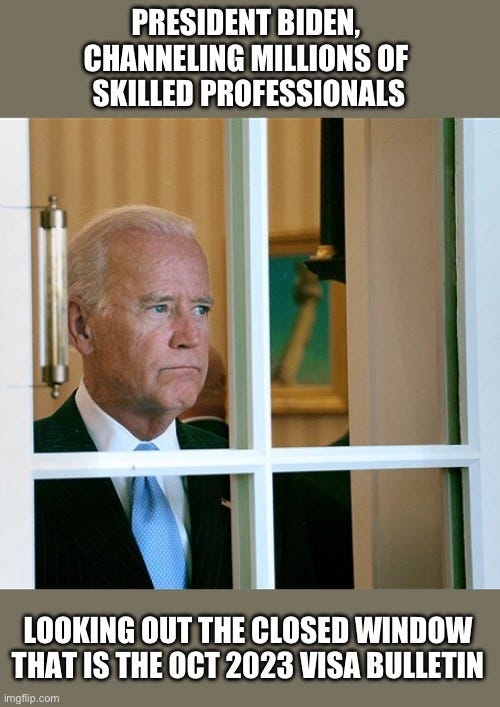The October 2023 Visa Bulletin and the New Normal
This post explores, at a high level, the challenges ahead for EB (Employment-Based) Immigration
In the Presidential Election of 1972, incumbent President Richard Nixon won re-election in a landslide. He won 49 states versus the challenger, U.S. Senator George McGovern. After the election, there was a famous quote attributed to Pauline Kael, a film critic for the New Yorker: “I can’t believe Nixon won. Everyone I know voted for McGovern.”
[Note that this quote has been debunked as not true but it is one of those famous apocryphal quotes that persists].
I think about that quote a lot when I think about Employment-Based immigration. Why?
Because “everyone I know” cares about the Visa Bulletin and the H-1B Cap and all the various ways that it seems increasingly impossible for skilled professionals to immigrate to the United States legally.
But it turns out “everyone I know” represents a sliver of the U.S. population (like the friends of Pauline Kael), and things are so far afield from my concerns that we are on the verge of shutting down the U.S. government, not because of how screwed up the most recent Visa Bulletin is, but rather over U.S./Mexico border policy. Of course, these things are not totally unrelated in that we cannot seem to get any improvement to legal immigration while the U.S./Mexico border policy appears unsettled.
There is no getting around the political reality in 2023 that one of the two major political parties in the United States is basically fixated on the U.S./Mexico border as the only thing that really matters when it comes to “immigration.” And given that we are a couple months away from starting a Presidential election year - one that will likely be very close, like the last 2 Presidential elections, in 2020 (Biden won) and 2016 (Trump won); I fear that things are not likely to get better in the short term for EB (Employment-Based) immigration.
FY2024, which starts on October 1, 2023, is going to be rough.
The cut-off dates listed in the October 2023 Visa Bulletin are much worse than probably anyone anticipated. Even the U.S. Department of State itself was way off in its earlier pronouncements. As one example:
The August 2023 Visa Bulletin in the End Notes at Section F suggested that at the start of fiscal year 2024 (October 2023), EB-1 India would return to the Final Action dates of the July 2023 Visa Bulletin - which should have been February 1, 2022. Instead, the October 2023 Visa Bulletin puts the Final Action cut-off date for EB-1 India at an abysmal January 1, 2017.
To use language from the Federal Reserve, cut-off dates in the Visa Bulletin for EB-2 ROW (Rest of World) and EB-1 India and China do not appear transitory; they appear entrenched.
Employers and individuals (and their lawyers) are going to have to re-calibrate strategies in light of this new normal. It is clear that the post-pandemic economy has more and more foreign nationals chasing the same, stale, inadequate limited number of H-1Bs and green cards.
USCIS policies meant to help, like faster processing of EB I-485s and expansion of premium processing to all categories of I-140s, have seemingly made backlogs more acute.
Priority date retention seems more critical than ever, particularly for Indian-born candidates.
Many people will, quite reasonably, give up.
I fear the backlogs are going to create an acceleration of concern and sadly the Visa Bulletin woes will be fertile territory for “too-clever-by-half” schemes. Consultants and other social media gurus will be out selling solutions.
With that said, I have my own variety of niche thoughts. But no snake oil here!
I do hope to be more active in posting analysis on the newsletter. I welcome your comments and questions.
Stay strong people!






Robert... Thanks for the quick background and analysis. Always insightful to read your thoughts.
Can you expand on what's the realistic backlog we are looking at for eb1? I have come across a number (800k or may be a million) of overall EB cases pending and my tiny brain says that this number is theoretically impossible to overcome especially with the latest final action date of 2017 as from now onwards, the movement of eb1 final action dates is going to be super slow.